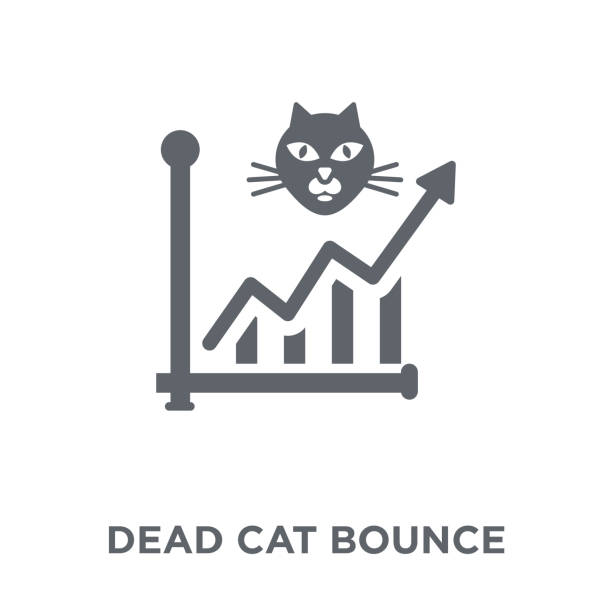Table of Contents
A dead cat bounce is a short-term price movement, usually downward, after a prolonged period of decline. It’s also known as a “bear market rally.” It is typically considered to be an insignificant or inconsequential move that isn’t indicative of any real change in the underlying trend (such as when you see an animal corpse bouncing around on the street). However, in the realm of investing, investors typically view this phenomenon differently. They hold the belief that although prices may have reached their lowest point during an extended bear market period, there is still a possibility for recuperation in the future.
What is it?
A dead cat bounce is a temporary recovery in the price of a declining stock. The term is derived from the expression “trying to revive a dead cat,” which was employed by Wall Street traders to depict the fruitless endeavor of reviving a creature that had been struck by a vehicle and was beyond any form of assistance.
The term first appeared in print in The Economist magazine in 1986: “It is hard to see how [the dollar] could stage anything more than a ‘dead cat’ bounce.” But its use predates this date; it may have originated with traders on Wall Street itself, where it would have been common for them to joke about losing money on their investments and then seeing these losses turn around unexpectedly (though still not enough for them to make any profit).
Why are stocks called cats in the first place?
A dead cat bounce is a short-lived and insignificant rally in a falling market. The phrase was first used to describe a particular type of chart pattern that sometimes appeared at the end of long bear markets (i.e., when prices are falling).
It’s also used to refer to a stock that has fallen so far that it can only go up from there, it’s “dead” because any further drops would result in bankruptcy or liquidation for its owners (and therefore no one will buy it).
A dead cat bounce can be short-lived. It is a short-term recovery in the price of a declining stock. The name is derived from the idea that even a dead cat will bounce if it falls from a great height.
What Does a Dead Cat Bounce Tell You?
A dead cat bounce is a temporary recovery in the price of a security after a prolonged decline. It can be caused by various factors, including:
Traders who buy stocks that have been beaten down but aren’t fundamentally sound, hoping for further declines so they can buy more shares at lower prices;
Traders who are looking for any sign that things are improving;
Short sellers covering their positions (buying securities they’ve previously sold).
Examples
The stock market is a great example of a dead cat bounce. During significant declines in stock prices, it is typical for investors to cash out and sell their shares, leading to a prolonged downward trend that may continue for weeks or even months. The prices may eventually stabilize, but they often do so at lower levels than before.
Another example would be the fall in value of cryptocurrencies, including Bitcoin, Ethereum, Litecoin, and Ripple, which have all undergone notable declines following their record high prices earlier this year. As these currencies continue to fall further into what some call “crypto winter”, the period between January 2019 through April 2020, it’s possible they’ll experience small recoveries before resuming their downward trend once again later this year.
How Long Can a Dead Cat Bounce Last?
Typically, a dead cat bounce lasts for only a few days, but in some cases, it may persist for a few months.
Causes
A dead cat bounce is a temporary recovery in the price of a declining stock. The term was coined by analysts who would observe that even a dead cat will bounce if it falls from a great height, but once it hits the ground it won’t get up again.
This type of recovery can happen for several reasons:
Traders are buying back shares because they think they may be able to sell them at an even higher price later on. This type of investor behavior has been called “buying on bad news” because these investors are betting on further declines in order to make money off their purchase later on (and this kind of speculation can lead to further declines).
It could also mean that there were some fundamental issues with previous estimates about how much value companies hold for example, when oil prices dropped sharply during 2014-2015 many companies discovered that their reserves were worth less than previously thought due to lower cost extraction methods being used by competitors
What Is the Opposite of a Dead Cat Bounce?
The opposite of a dead cat bounce is not just another kind of bounce, but rather an actual animal that has been killed by the impact from falling from too great of a height.
Limitations in Identifying
When attempting to identify a dead cat bounce, there are several crucial points to consider. It’s crucial to keep in mind that the market is not a precise science, and various factors can affect stock prices at any moment, making it impractical to forecast them all accurately. Additionally, even if you are confident in your analysis and foresee no further decline for a specific stock or any other, unforeseen events can still happen. The market does not follow a linear pattern and can behave erratically over short periods, so it’s crucial to be prepared if your predictions don’t pan out exactly as planned or if they fail altogether.
Conclusion
Dead cat bounce is a temporary recovery in a declining market.
In fact, it happen all the time and they’re nothing to be afraid of they’re just part of normal market fluctuations. If you examine the chart of any investment over any timeframe, you will observe them, even if you are unaware of their identity. A dead cat bounce is a temporary recovery in the price of an asset that has been declining for some time. It can last anywhere from a few days up until several months before prices resume their downward trajectory.

Ethan Moore, crypto and stock trader since 2012. Co-founder of Blockwatch experts team.
